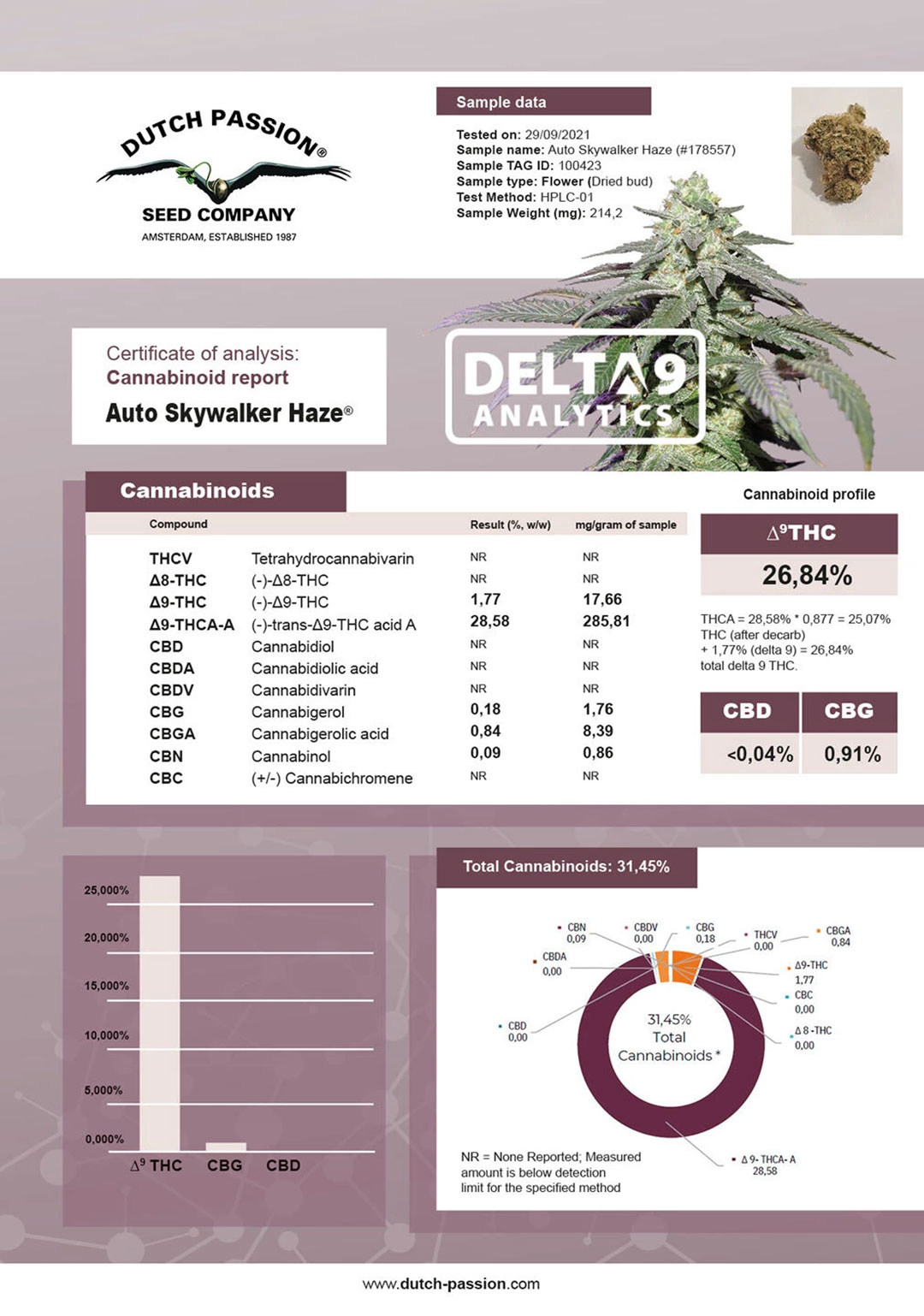THC vs TAC: Why Total Active Cannabinoids matter

Ever felt confused by the topic of TAC (Total Active Cannabinoids)? It’s a tricky topic, but easier to understand when you take a step-by-step approach. Consider a home-grown fresh bud sample with 0% THC and 16% THCA. THCA is the acid non-psychoactive version of THC. It breaks down into the psychoactive THC variant when heated in a vape, joint etc.
The same principle is true of CBD, whose acid version is known as CBD-A. Other cannabinoids such as CBG etc tend to occur naturally in their acid state. When it comes to THCA, 87.7% is converted into THC when heated. This means that a strain with 16% THCA will convert to 14% active THC. The TAC for a bud sample with 16% THC-A is therefore 14% THC.
What is Total Active Cannabinoid Content (TAC)?

When a professional laboratory analyses a cannabis sample, the results usually show the cannabinoids present in their acid version e.g. THC-A. A bud sample with an impressive sounding 31% THCA would have a total active THC content of nearer 27%.
Total Active Cannabinoid (TAC) levels show you the ‘real world’ levels of active THC and other cannabinoids e.g. CBD, CBG etc that are present. When it comes to cannabinoids, growers tend to be most familiar with THC and CBD. But most connoisseur cannabis lovers claim a full-bodied cannabis strain with high THC levels and a generous wide-spectrum entourage of minor cannabinoids & terpenes is superior to a strain without the minor cannabinoids.

Lab analysis of Auto Cinderella Jack showing 25.9% THC with 0.19% THCV, 0.45% CBC, 0.13% CBD, 1.76% CBG and 0.19% CBN.
TAC vs total cannabinoid content
The total cannabinoid content of a bud sample shows the levels of all the acid versions of the cannabinoids present in addition to the active versions. So a bud sample with 20% THCA, 1% THC, 3% CBD-A & 1% CBD would have a total cannabinoid content of 25%. The TAC, however, would be nearer 22%. Whilst there is often a small amount of active cannabinoids (e.g. THC & CBD) in the bud, the majority of the cannabinoids are typically present in their acid form i.e. THC-A, CBD-A, CBG-A etc. This means that the total cannabinoid content is higher than the amount of total active cannabinoids (TAC).
Remember that the real-world active cannabinoid levels are always a few percentage points lower than their acid versions.
A strain analysis with 0% THC & 25% THC-A would have total active THC levels of (25% THC x 0.877=) 22%. However, the total cannabinoid content would be 25%.
Nearly all cannabinoids are derived from CBG (Cannabigerol) which is often known as the mother cannabinoid. The cannabis plant uses various biosynthetic pathways to create other cannabinoids from CBG. The first CBG-rich cannabis strain to be created was Dutch Passion CBG-Force, which contains 10-15%+ CBG-A in the buds. THC/THC-A levels are always below 0.2%. Auto CBG-Force is available to those that prefer growing autoflowering cannabis seeds.
TAC vs total aerobic content
TAC (Total Active Cannabinoid content) shouldn’t be confused with total aerobic count (also sometimes abbreviated to TAC). Total aerobic count is a measure of the level of microbial activity related to a particular crop. It is infrequently discussed in the context of professional cannabis cultivation.
Cannabinoids, terpenes, flavonoids and the entourage effect
The presence of plenty of minor cannabinoids in addition to a high THC content is thought to produce a better high. This is known as the ‘entourage effect’. Although the entourage effect has little scientific support at this point, most experienced cannabis users would claim they get a clearly superior effect from a strain with a generous side-serving of minor cannabinoids.
Cannabis flavonoids are the natural plant pigments with some research suggesting they have useful anti-inflammatory properties and medical potential. Add a tasty terpene content to your multi-cannabinoid nugs and you have some top-shelf cannabis buds to look forward to!
How to improve TAC and terpene content in your buds
Many professional growers work hard on several key aspects of their grow in order to produce a crop with a high level of cannabinoids and a rich terpene profile.
• Use of a quality LED grow light is something all the top growers now insist on. THC levels should automatically move up a level and minor cannabinoids also tend to increase under LED. Just for info, clones of a Dutch Passion gene bank strain produce 17% THC when grown under HPS but 23% THC under LED. LED really is worth the upgrade.
• Use of supplemental UVA/UVB lights is another way to nudge up both the terpene content as well as the TAC.
• Try to maintain your cannabis plants in the nutrient and optical sweet spot all the way from cannabis seed to harvest. Yes, this is far easier said than done! But by minimising plant stress, and optimising conditions you give your cannabis plants the best chance to reach their full genetic potential with maximised terpene and cannabinoid levels. Use of slow-release organic nutrients (BioTabs are especially recommended and fully proven) have been particularly useful to those that struggle with over/under feeding issues often associated with bottled nutrients.
• It sounds obvious but choose your cannabis seeds wisely. Even the world’s best growers can’t achieve high THC/TAC levels with cheap, poor quality cannabis seeds.
Why does TAC in cannabis products matter?
A high TAC level shows that the grower has worked hard to optimise their grow room and push their cannabis seeds to the full genetic potential. The result should be luxuriously enjoyable weed with memorable quality levels.
Not only should THC levels hit the spot, but the cannabinoid cocktail from a broad range of phytocannabinoids always seems to add more enjoyability compared to a strain without the cannabinoid entourage (‘Phyto’ simple means plant-related).
As a side effect of well managed grow in optimised conditions, terpene levels should also be maximised. But even a master grower with optimised conditions can’t push their plants further than the genetics will naturally allow.
If you’re looking to grow the finest cannabis seeds check out the Dutch Passion High THC cannabis seed selection. These are the only strains in the Dutch Passion collection which can hit (and sometimes exceed) 25% THC.
Cannabinoid profile testing case study

This example may help you understand the sometimes-confusing terminology discussed so far, consider the following bud sample:
| Cannabinoid | Percentage |
| THC | 1.5% |
| THCA | 23% |
| CBD | 0.2% |
| CBDA | 4% |
| CBG | 0.1% |
| CBGA | 7% |
Only a small proportion of the cannabinoids in the fresh bud sample are immediately available in their active form: 1.5% THC + 0.2% CBD + 0.1% CBG = 1.8%
Total cannabinoid content: The total cannabinoid content is (1.5% THC) + (23% THCA) + (0.2% CBD) + (4% CBDA) + (0.1% CBG) + (7% CBG) = 35.8%
TAC. Once decarboxylated (e.g. due to heat from a vape or joint) the TAC available from the bud would be (1.5% THC) + (0.877 x 23% THCA) + (0.2% CBD) + (0.877 x 4% CBDA) + (0.1% CBG) + (0.878 x 7% CBGA) = 31.6%
Note: a conversion factor of 0.878 is used when converting levels of CBGA into CBG.
Total Active Cannabinoids FAQ

If much of the science seems confusing, one useful take-away is to remember that a cannabis strain analysis that shows e.g. 25% THCA would translate into a slightly lower usable active THC content of 22%.
Are acidic cannabinoids part of TAC content?
No. Acid versions of cannabinoids are not regarded as the ‘active’ form. Once the acid versions of the cannabinoids are heated, they change into the active version via a process known as decarboxylation. Some Carbon Dioxide is produced during this process. The release of Carbon Dioxide is what causes the loss-in-mass when the acid cannabinoid version converts to the active version.
How do you calculate total CBD or THC content?
To calculate THC level, just multiply the THC-A value by 0.877
To calculate CBD level, multiply the CBD-A value by 0.877
What is a high amount of total active cannabinoids?
The Dutch Government regularly monitor the coffee shops for bud potency. Over the last few years they have shown that most cannabis sold in coffee shops has a total active cannabinoid content of around 16% THC.
Is a higher total cannabinoid content better?
Generally speaking, yes. When faced with a choice of two bud samples, each with a lab-analysis, most people would opt for the strain with the higher total cannabinoid content. But other factors also need to be considered. An outstanding terpene profile could persuade a buyer to opt for flavour even if the strain has a slightly lower total cannabinoid content than alternative options.
Is TAC always displayed on cannabis product labels?
Often not. Where cannabis is sold legally with an analytical report the values often reported are those for the acid versions of the cannabinoids. If you bought some buds with 20% THC-A that would mean (20% THC x 0.877 =) 17.5% THC.





























